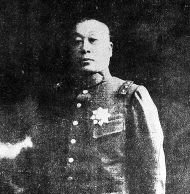Views
Zhū Zǐqiáo 朱子橋 (1874-1941)
|
| Notable Associates: |
|
Zhū Zǐqiáo 朱子橋 (1874-1941) was a career solider and lay Buddhist. He was responsible for a great many works of Buddhist restoration in China's Northwest in the 1920s and 1930s, including innumerable charitable works, the rebuilding of temples, the protection of Buddhist objects, and the re-printing of a Sòng dynasty canon.
Contents |
Biography
Zhū received a traditional education. At age 19, he took a position in the army. After the first Sino-Japanese War, he was stationed at a number of different posts all over China. He continued his service in the Chinese military until the death of Yuán Shìkǎi 袁世凱 in 1916, at which point he was appointed governor of Guǎngdōng 廣東.
In 1917, Sun Yat-sen was working to reestablish the Republic government. Zhū supported Sun's efforts, but rather than work for that government, he traveled to Northern Jiāngsū 江蘇 to establish an agricultural company for the sake of the people of the Jiāngnán 江南 region. In 1922 he took a major position with the China Railway Company. He did not officially retire from all duties in the Army until 1925.
Early in his life, Zhū had been skeptical about Buddhism, but under the influence of his friend Chéng Déquán 程德全, he converted to Buddhism. At some point during his tenure with the Army, Zhū had been stationed in Harbin 哈爾濱, where he provided a great deal of assistance to Tánxū 倓虛 as the latter worked to establish temples in China's Northeast in the early and mid 1920s. In 1927, Zhū assisted financially and with the organization of relief efforts for those caught in major floods in Shāndōng and Hénán 河南.
In 1929, Zhū discovered a nearly complete edition of the Sòng Dynasty-era Qìshā Canon 磧砂藏 in Xī'ān 西安. He went to Shànghǎi 上海, where, with the help of Dīng Fúbǎo 丁福保, Jiǎng Wéiqiáo 蔣維喬, Lǐ Jīngwěi 李經緯, and others, he established an organization to fund a photoprint publication of that canon. This group dispatched the monk Fànchéng 範成 to search around Shānxī 山西 to find the rest of the canon. Fànchéng unearthed a Jīn 金 dynasty canon at Guǎngshèng Temple 廣勝寺 in Zhàochéng County 趙城縣, which was used to fill in the missing pieces of the Sòng canon. The entire canon (in 500 volumes) was published in Shànghǎi in 1935.
In 1936, Zhū was ordered by the government to return to duty in the Army to aid in the resistance against the Japanese army. For much of the Second Sino-Japanese War, Zhū was stationed in Xī'ān, where he worked diligently to protect and restore the many Chinese Buddhist artifacts in the region. He helped restore ancient temples, rebuild neglected stūpas, establish Buddhist seminaries including the Xīngshàn Temple Buddhist Seminary 興善寺佛學院 (though most were short-lived). This last Seminary was directed by Tánxū, and one of the lecturers was Huáqīng 華清. During all of his charitable and restoration work, Zhū was personally responsible for unearthing and preserving a number of Buddhist artifacts from the Táng, Sòng, and Míng Dynasties.
He died without illness while meditating on January 13, 1941.
Important Works
Notable Students
Notes
References
- Shì Dōngchū 釋東初. Zhōngguó Fójiào jìndài shǐ 中國佛教近代史 (A History of Early Contemporary Chinese Buddhism), in Dōngchū lǎorén quánjí 東初老人全集 (Complete Collection of Old Man Dongchu), vols. 1-2. Taipei: Dongchu, 1974 Pp. 1.329-337.
- Yú Língbō 于凌波, ed. Xiàndài Fójiào rénwù cídiǎn 現代佛教人物辭典 (A Dictionary of Modern Buddhist Persons), 2 vols. Taipei: Foguang, 2004. Pp. 1.336a-339c.

